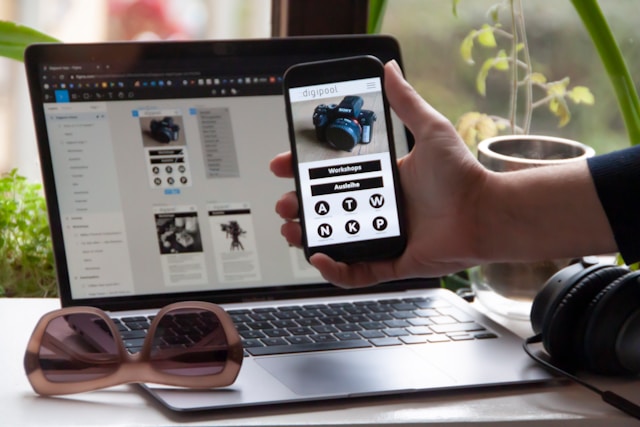How to keep visitors on your site through excellent web design
One of the biggest search engine optimization (SEO) factors is how long visitors stay on your site. Do they land on your page and keep reading or do they click the back button and land in the Google search results again? You must increase the “stickiness” of your site by drawing people in to keep reading. Providing excellent content should be a given in your SEO efforts. However, there are also some ways used by the website design agency to develop a design to draw visitors in and keep them engaged. Let’s take a look at nine ways to improve your website’s stickiness via good web design.
Quick Links
Simple Navigation Options
User experience is one of the most vital aspects to web design. Your search engine marketing, content marketing and SEO efforts are designed to drive traffic so people find the site. The next thing you need to do is make sure they find the information they’re looking for in the most efficient way possible.
Your navigation options play a big part in this area. There’s a fine line between providing an intuitive way to navigate the site and giving visitors too many choices. When visitors are presented with far too many navigation options, the tendency is to leave your site because they become confused. You’ll discover better site stickiness by streamlining the navigation choices because visitors can more easily make a decision about what to click on next.
Pick the Right Fonts & Colours
Paying attention to colour combinations helps create an appealing visual experience. Don’t choose colours that cause eye strain for your visitors. For example, stay away from dark page backgrounds with dark font colours. Use fonts that are easy to read. One of the most used fonts is sans-serif because it’s easy to read.
Use Minimalism with Your Design
Keeping the look and feel of your website simplified helps readers immediately access the content they’re looking for. They will stay on your pages longer and click through to other pages because they aren’t distracted by too many bells and whistles. Make sure your pages aren’t cluttered with too many images or banners. Create plenty of white space so users continue reading.
Optimize for Speed
Google pays attention to your site’s loading time. They do this because website visitors simply won’t wait around for a slow-loading page. Including design elements that slow your pages down by even one second will cause visitors to leave your site. This will increase your bounce rate and negatively affect your overall search rankings. Use tools like traffic monitor to gain perspective on how your site is performing in this area.
Use Responsive Design
Responsive web design is one of the easiest ways to improve stickiness and draw customers into your website. This is a type of design that makes sure each page shows up perfectly no matter the device it’s being shown on. This means that users will get a great experience on desktops, laptops, mobile phones and tablets. Google has been vocal about the fact that it penalizes websites that don’t use responsive design. Don’t make the mistake of using old, outdated design templates.
Use Clean Code
There are some types of coding that are harmful to your site in terms of search engine capability to crawl the content. These include 3rd-party plugins or JavaScript. You might have used an inexperienced web developer who created a clunky code that pushes vital keywords and content too far down each page. Google’s crawlers might give up their crawl search prior to reaching those important aspects of your site. The result is a site that gets less traffic. It’s difficult to draw visitors into a site that isn’t getting many visitors to it in the first place.
Use a Blog
Don’t create a website that looks too corporate or technical. Remember that visitors will stick around longer if they have the opportunity to stay engaged. Beyond a great home page, blog content is the next best place to direct visitors to. The reason is they will read one post and then continue to the next if you have a good internal linking plan in place. Make sure you have your web developer design clean and easy-to-read blog pages so users remain engaged on the site.
Make Good Use of the Above-the-Fold Area
While some people argue today that the fold area isn’t as important as it used to be because of various screen sizes in use, the area above the fold is indeed vital. It’s been shown that users invest 57% of their time above the fold. This means you need to use design options that allow you to optimize this area. Use this space in such a way that content draws readers in and encourages them to keep scrolling down the page. Here are some ways to accomplish this:
- Use a descriptive, clear headline: Make sure visitors understand the benefits of visiting each page. Use power words and be brief. Hire a good copywriter if you need to.
- Use a clear call to action (CTR): A quality CTR above the fold improves your chances to draw visitors in enough that they continue reading.
- Use media: Videos, images and audio help make your point alongside written content.
Provide Up-to-Date & Valuable Content
Don’t underestimate the power of your content when thinking about web design. You can use all the above design elements and then fail to draw customers in because your content falls flat. Use useful tips, case studies, examples and other content that informs, teaches and creates a great relationship between you and your readers.
Web design is a critical aspect to drawing visitors in, keeping them on your site longer, encouraging them to click to other internal pages and ultimately selling them your products and services. Don’t become overwhelmed by the above tips. Start with one that your site is deficient in. Get that working. Then, continue going step-by-step until your site performs better.
Web and Mobile App Development Trends to Consider in 2024
As technology continues to evolve at a rapid pace, staying ahead is essential for developers and…
0 Comments8 Minutes
What Are the Top 10 Web Development Tools for Beginners?
Web development is the art of building and updating web pages that Internet users Interact with.…
0 Comments13 Minutes
Does Your Branding Need A New Look?
From time to time, it’s important and necessary to check over your branding, to ensure that it is…
0 Comments4 Minutes
Essential Skills for AI-Driven Digital Marketing
Digital marketing is changing a lot. Artificial intelligence (AI) is becoming really powerful and…
0 Comments10 Minutes
A Handbook for Crafting Outstanding Email Automation Plans
Email marketing is an essential tool for communication in digital marketing platforms. Managing…
0 Comments8 Minutes
Branding – What It Means for Your Business
Every single one of us has our own personal brand. Unique to each of us, this lies in who we are…
0 Comments5 Minutes
How to Create a successful SEO campaign, without an SEO agency
The quest for industry-leading SEO can be as financially draining as it is profitable. Despite its…
0 Comments8 Minutes
Safeguarding the Digital Realm: The Role of Machine Learning in Cybersecurity
The digital realm, an expansive network of interconnected devices and data, forms the foundation…
0 Comments8 Minutes








